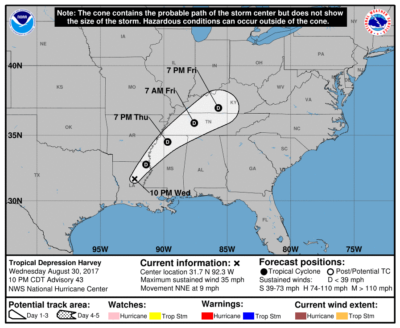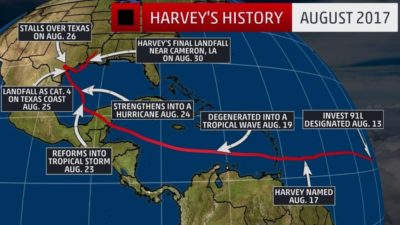Hurricane Harvey caused havoc in the Southern Central United States region. According to the National Hurricane Center, Harvey was downgraded to a tropical depression on Wednesday August 30th, 2017. The storm continues to have fierce winds and rain moving into Northern Mississippi and Central Tennessee as shown in the picture to the right. CNN statistics reported the following numbers, on Sept 1st, 2017:
- Harvey dropped 27 trillion gallons of rain (51 inches) over Texas and Louisiana in 6 days
- 72,000 people have been rescued
- Estimated 30,000 people needing temporary shelter (Griggs, 2017).
- Current estimated cost of this devastating storm is 75 billion (Elam, 2017)

Hurricane Harvey was named on August 17th, 2017 as it moved through the Caribbean Sea. Harvey strengthened when it started moving through the Gulf of Mexico hitting Texas land as a Category 4 hurricane on late August 25th, 2017. Picture to the left gives a synapse of Harvey’s history. On Aug. 23rd, Governor Greg Abbott ordered the, already assembled, State Operations Center to elevate their readiness to level three with further levels of elevation to occur on Aug. 24th. Governor Abbott, also expressed the importance of his citizens that are in the path to make “their own emergency preparations” (Office of the Texas Governor, 2017). While hurricane Harvey stalled over Texas, record rainfall occurred requiring the Governor of Texas to request federal assistance.

Federal Emergency Management Agency (FEMA) released a report on August 25th, 2017. The Department of Homeland Security (DHS) and FEMA briefed President Trump on the potential for disaster and with this information Trump declared a Major Disaster allowing for federal funding to be made available for the state of Texas. FEMA’s National Response Coordination Center in Washington, D.C. and Regional Response Coordination Center in Denton, TX were activated. FEMA provided Incident Management Assistance Teams to support Texas and Louisiana state Emergency Operation Centers. In preparation of the storm 96,000 liters of water, 306,000 meals and 4,500 tarps were staged at incident Support Bases. Additional support for Hurricane included:
Federal Response
- Three Incident Support Bases
- Six Urban Search and Rescue task forces
- Mobile Emergency Response Support personnel and equipment are in Fort Worth, TX
- National Flood Insurance Program are staged to support assessments following event (already preparing recovery operations)
Additional Efforts
- American Red Cross opened seven shelters
- U.S. Army Corps of Engineers has deployed liaison officers to state emergency operation centers
- U.S. Bureau of Safety and Environmental Enforcement (BSEE) hurricane response team is observing Gulf of Mexico oil and gas activities
- Corporation for National and Community Service has placed more than 700 members of AmeriCorps disaster response team
- U.S. Department of Health and Human Services has deployed 460 personnel from National Disaster Medical System and the Office of the Assistant Secretary for Preparedness and Response (ASPR)
As Harvey stalled over Texas additional resources continued to arrive at Incident Support bases increasing food, water, tarps, and now staging generators. August 27th ASPR reported that the National Business Emergency Operations Center was activated providing coordination between government and private sector organizations.
On September 1st, Houston Mayor, Sylvester Turner, declared the city “is open for business.” With minor improvements of receding waters and slow increase of metro transit the community is starting the road to recovery (Sanchez, Yan, and Simon; 2017).
As of Sept. 5th, 2017, the Salvation Army response team were focusing on recovery with a 25% focus on continued rescue support (quoted by Elam, 2017). ASPR Critical Infrastructure Protection (CIP) reports current recovery operations are:
Patient Direct Care
- Hospitals are preparing their financial impact reports.
- Pharmacies continue to open and has begun supporting the community needs.
- Community health centers are starting to operate in the area.
- Hospitals that are functioning off generators continue to have fuel supply issues.
Other recovery operations noted
- Mass fatality management continues to wind down.
- Disaster task force remains in Texas with no related needs, at this point.
FEMA has started employing Houston residents for cleanup, providing small business support, and is working to prevent spread of disease through mosquito control. Association of State and Territorial Health Officials (ASTHO) reports that U.S. Small Business Administration (SBA) has opened two recovery centers and will open more soon. Currently the SBA is offering more than 9,200 loans with 1,000 for businesses in hopes that communities can rebuild and support themselves. As of Sept. 15th, FEMA closes this disaster incident; although, a long road to recovery continues with FEMA and many other organizations continuing to lend their support to the several counties in need.
Resources:
Association of State and Territorial Health Officials Harvey/Irma Sit Rep #9.
Elam, Stephanie (Sept. 8th, 2017). Parts of Texas still in rescue and recovery mode, 2 weeks after Hurricane Harvey. CNN. http://www.cnn.com/2017/09/08/us/hurricane-harvey-recovery/index.html
Federal Emergency Management Agency (FEMA) (August 25th, 2017) Federal Government Mobilized to support Federal, State, Local, and Tribal Partners as Hurricane Harvey Approaches the Gulf Coast. FEMA https://www.fema.gov/news-release/2017/08/25/federal-government-mobilized-support-federal-state-local-and-tribal-partners
FEMA (2017). Texas Hurricane Harvey (DR-4332). FEMA. https://www.fema.gov/disaster/4332
Griggs, Brandon (Sept. 1st, 2017). Harvey’s Devastating Impact by the Numbers. CNN. http://www.cnn.com/2017/08/27/us/harvey-impact-by-the-numbers-trnd/index.html
Office of the Texas Governor (August 23rd, 2017). Governor Abbott Increases Readiness Of State Operations Center As Tropical Depression Harvey Approaches Gulf Coast. https://gov.texas.gov/news/post/governor-abbott-increases-readiness-of-state-operations-center-as-tropical-
The Weather Channel (Sept. 2nd, 2017). Historic Hurricane Harvey’s Recap. The Weather Channel. https://weather.com/storms/hurricane/news/tropical-storm-harvey-forecast-texas-louisiana-arkansas
Sanchez, Ray; Yan, Holly; and Simon, Darran (Sept. 1st, 2017). Harvey Aftermath: Houston ‘Open for Business’; Other Cities Suffering. CNN. http://www.cnn.com/2017/08/31/us/harvey-houston-texas-flood/index.html

